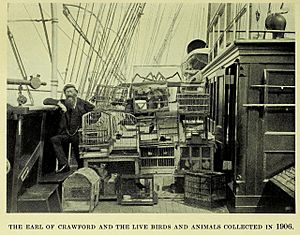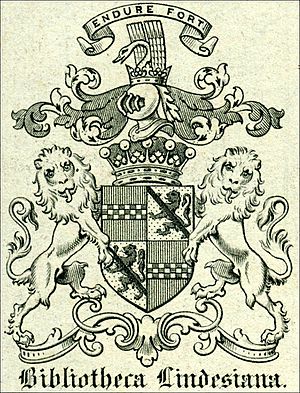James Lindsay, 26th Earl of Crawford facts for kids
Quick facts for kids
The Earl of Crawford and Balcarres
|
|
|---|---|

Caricature of Lord Crawford by Leslie Ward
|
|
| Member of Parliament for Wigan | |
| In office 1874–1881 Serving with Thomas Knowles
|
|
| Preceded by | John Lancaster Henry Woods |
| Succeeded by | Francis Sharp Powell Thomas Knowles |
| Personal details | |
| Born |
James Ludovic Lindsay
28 July 1847 Saint-Germain-en-Laye, France |
| Died | 31 January 1913 (aged 65) |
| Political party | Conservative |
| Spouse |
Emily Florence Bootle-Wilbraham
(m. 1869–1913) |
| Children | 7 |
| Parents | Alexander Lindsay, 25th Earl of Crawford Margaret |
| Alma mater | University of Edinburgh |
James Ludovic Lindsay (born July 28, 1847 – died January 31, 1913) was a very talented British nobleman. He was known as the 26th Earl of Crawford and 9th Earl of Balcarres. He was interested in many things, including astronomy, politics, and collecting rare books and stamps.
He was a member of the important Royal Society and even became president of the Royal Astronomical Society in 1878. He was also a well-known Freemason.
Contents
Early Life and Education
James Ludovic Lindsay was born in Saint-Germain-en-Laye, France, on July 28, 1847. He was the only son of Alexander Lindsay, 25th Earl of Crawford and his wife Margaret.
As a child, he had asthma. Because of this, he spent a lot of time at sea. During these trips, he studied parts of his family's large library. He later attended the University of Edinburgh.
Astronomy Discoveries
Crawford loved astronomy from a young age. With his father, he built a private observatory at Dunecht in Aberdeenshire. He hired David Gill to set up the observatory with the best equipment.
David Gill later took the first photograph of the Great Comet of 1882. This helped start astrophotography, which is taking pictures of space. It also helped with mapping the stars.
Expeditions to Observe Eclipses
Crawford led several trips to observe important sky events. In 1870, he went to Cadiz to see a solar eclipse. He traveled to India in 1871 for another solar eclipse.
In 1874, he went to Mauritius to observe the transit of Venus. This is when Venus passes directly in front of the Sun. On these trips, he worked with photographer Henry Davis.
Helping the Royal Observatory
In 1888, Crawford heard that the Edinburgh Royal Observatory might close. He decided to help. He donated many astronomical instruments and his books on science and math.
Thanks to his generous gift, a new observatory was built. The new Royal Observatory, Edinburgh opened in 1896. It was located on Blackford Hill.
The Bibliotheca Lindesiana
The Bibliotheca Lindesiana was a huge and impressive private library. Its name means "Lindsay's library." Both James and his father worked hard to build it.
It became one of the most important private collections in Britain. It had many rare books and old manuscripts. The library was kept mostly at Haigh Hall in Lancashire.
In 1901, the collection of manuscripts was sold. It went to Enriqueta Augustina Rylands for the John Rylands Library. Other parts of the library were later given to national libraries.
Philately (Stamp Collecting)
Crawford was also very interested in philately, which is the study and collection of stamps. His interest grew from his work with the family library. He bought a huge collection of books about stamps.
This collection belonged to John K. Tiffany, who was the first president of the American Philatelic Society. Tiffany's collection was already the largest in the world. Crawford added even more to it from all over Europe.
He even planned to leave his stamp library to the British Museum in his will. The Crawford Medal was created in his honor. It is given each year for important new studies in stamp collecting. By the time he died, Crawford had the greatest stamp library of his time.
Political Career
Crawford was a member of the Conservative Party. In 1874, he was elected as a Member of Parliament (MP) for Wigan. An MP represents a local area in the country's government. He held this position until 1880.
Military Service
Crawford served briefly as an Ensign in the Grenadier Guards. Later, as an MP, he became a lieutenant-colonel in the 4th Lancashire Rifle Volunteer Corps. In 1900, he was made an Honorary Colonel of the unit.
Family Life
On July 22, 1869, James married Emily Florence Bootle-Wilbraham. Together, they had seven children:
- Lady Evelyn Margaret Lindsay (1870–1944)
- David Alexander Edward Lindsay, 27th Earl of Crawford (1871–1940)
- Hon Walter Patrick Lindsay (1873–1936)
- Major Hon Robert Hamilton Lindsay (1874–1911)
- The Reverend Hon Edward Reginald Lindsay (1876–1951)
- Sir Ronald Charles Lindsay (1877–1945), a diplomat
- Hon Lionel Lindsay (1879–1965)
Lord Crawford passed away on January 31, 1913. His wife, Emily, died in 1934.
Other Achievements and Awards
In 1882, Crawford received an honorary degree (LL.D.) from the University of Edinburgh. The next year, he was recognized by the Royal Prussian Academy of Sciences. He also became a trustee of the British Museum.
He had a strong connection to Wigan. He was the head of the Free Library Authority there. In 1900, he was given the "Freedom of the borough" of Wigan, which is a special honor. From 1902, he was also a member of the Council of the Zoological Society of London.



